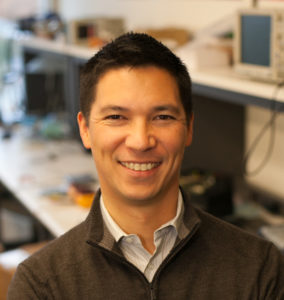Link Lab: A Visionary Laboratory
Written by Kamin Whitehouse, Link Lab Director and Commonwealth Associate Professor of Computer Science, School of Engineering and Applied Science
Society’s biggest grand challenges today — energy, health, transportation, and environment — can only be addressed when scientists and engineers from different disciplines work together. However, interdisciplinary research and training is harder to do when academic institutions are organized according to conventional disciplinary silos. To address this issue, the School of Engineering and Applied Science created the Link Lab: a visionary new laboratory that supports collaborative, interdisciplinary research and training. It is called the Link Lab because it “links” multiple departments through cross-cutting mechanisms such as shared lab space, joint hiring, and joint student/faculty mentoring.
The mission of the Link Lab is to enhance excellence in Cyber-Physical Systems (CPS) research: the science and engineering that bridges the gap between the cyber- and physical-worlds. CPS is an interdisciplinary field that is not well supported by traditional disciplinary study even though it is fundamentally changing the way that engineers think about societal grand challenges like transportation, energy, environment, and healthcare: just as the Internet revolutionized the business and social worlds, CPS technology will revolutionize the physical world. The Link Lab supports cross-cutting research that transcends traditional disciplinary boundaries, positioning our students to be leaders in this important and emerging area.
The Link Lab will house approximately 150 researchers in CPS and was designed from the ground up to be a truly collaborative space. It will include brainstorming and interaction spaces including shared lab equipment, team rooms, and brainstorming space. An open floor plan will promote cross-pollination between research groups while at the same time using furniture and layout to provide sound insulation and reduce interruptions, enhancing the technical depth and focus required for top-notch research. The space will also include numerous “touchdown” spaces and “hotel” desks to facilitate collaborations with visiting researchers from other labs and other universities. It is the first space in the Engineering School that will bring together researchers from so many different disciplines.
Only two years after starting the Link Lab, it is already having a major impact. UVA earned 3 of the 30 prestigious, competitive National Science Foundation cyber-physical systems awards in 2016 – more awards than any other university. In total, new multi-department, collaborative Link Lab proposals resulted in over $10M in external funding this year alone. These new projects will drive future innovation in both research and education.
By promoting collaboration across departments, the Link Lab will help build critical mass and increase visibility in an important cross-cutting research area, despite our small size compared to other top engineering schools. The Link Lab is a cornerstone in the Engineering school’s larger strategy to increase impact through cross-cutting initiatives. The Link Lab will be the first of several cross-cutting labs and will serve as a model for the future of the Engineering school, ushering in a new paradigm of interdisciplinary collaborative research and training in engineering.
- Musings on National Violin Day
- Making the Promise Real: How a UN Tax Convention Can Fulfill the UNDHR’s Vision
- Having a Drink With Your Donkey: The Absurd in Antiquity
- UVA Club of Atlanta: Virtual Pilates Class
- UVA Club of Fairfield/Westchester: Cavs Care - Food Pantry Donation Drive
- UVA Club of Phoenix: Hoo-liday Party

